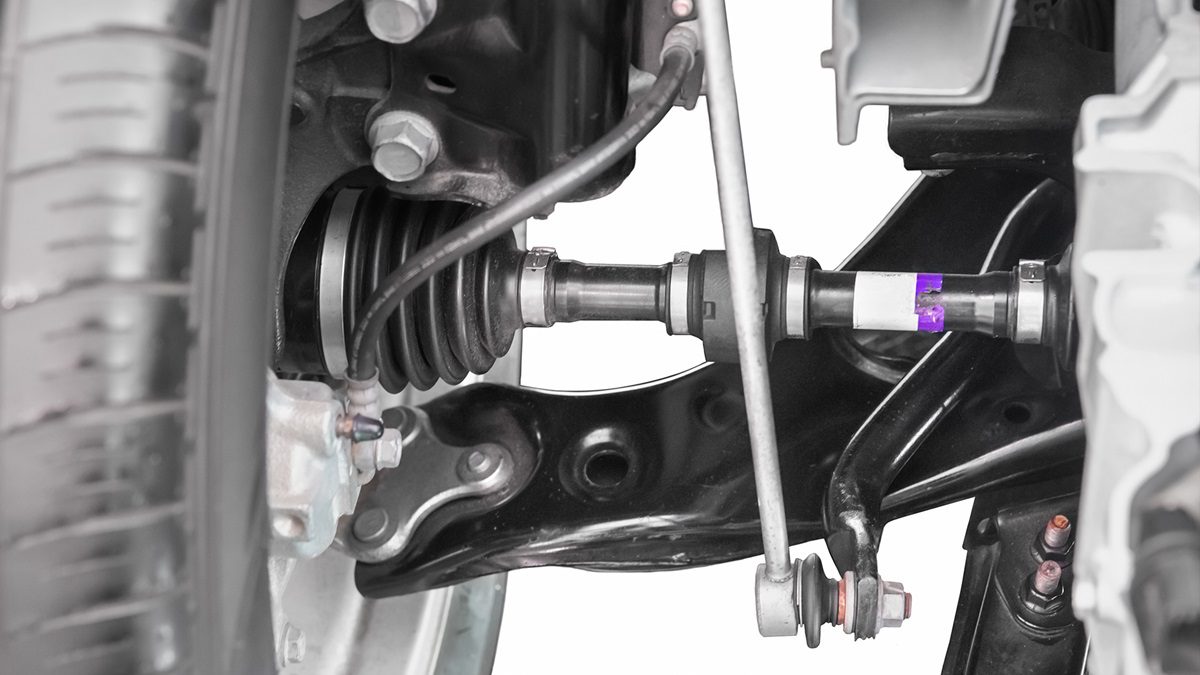How to Diagnose Jaguar Suspension Problems


It’s no secret that Jaguar vehicles are built for elegance and performance, but even the sleekest ride can hit a bump. Jaguar suspension problems are more common than you think and can sneak up before you know it. Ignoring them won’t just cost you comfort; it can compromise your safety.
We’ve seen it time and again at HEART Auto Care. That frustrating clunking noise? The slow dip of the front end? They’re often red flags pointing to Jaguar suspension problems. Let’s walk through how to diagnose what’s really going on beneath your ride.
What Are Common Signs of Jaguar Suspension Problems?
Jaguar suspension problems often show up through steering changes, tire wear, or a rougher ride.
Here’s what to look for when something feels off in your Jaguar’s smooth glide:
- Clunking or knocking sounds over bumps: Strange noises from the front or rear typically signal worn suspension parts like bushings, ball joints, or struts.
- Vehicle pulls to one side: If your Jaguar drifts even on a straight road, the suspension system may be out of alignment or have worn components.
- Uneven tire wear: Suspension problems create uneven pressure on your tires, leading to strange patterns or bald spots.
- Nose diving while braking: If your Jaguar dips sharply forward during stops, it might mean weakened struts or shocks.
- Oily or greasy shocks: Moisture around your shocks usually means they’re leaking hydraulic fluid, which limits their damping ability.
- Excessive bouncing after bumps: When a car keeps bouncing after hitting a pothole or speed bump, it’s a sure sign the shocks are shot.
These symptoms often point to bigger issues within the suspension system. As these parts wear out, signs of a bad car suspension can lead to reduced control and increased braking distance, putting your safety at risk.
Can You Drive a Jaguar With Suspension Problems?
Driving with Jaguar suspension problems is possible, but it’s risky and can worsen the damage.
Here’s why it’s a bad idea to delay repairs:
- Compromised control – Suspension keeps your tires in contact with the road. A faulty system reduces traction, especially in turns or rain.
- Increased wear and tear – Driving under stress from faulty parts accelerates damage to shocks, ball joints, tires, and even the frame.
- Longer stopping distances – A damaged suspension disrupts weight distribution during braking, increasing how far it takes your Jaguar to stop.
- More expensive repairs later – What starts as worn bushings or leaking struts can turn into full suspension replacement or damage to nearby systems.
It’s best to get ahead of problems. At HEART Auto Care, we often catch these issues during regular checkups before they become dangerous or costly.
5 Key Components to Check for Jaguar Suspension Problems
Your Jaguar’s suspension is made up of multiple parts working in sync. Diagnosing issues means checking each one carefully.
Below are the parts to inspect if you suspect Jaguar suspension problems:
- Control Arms – These allow the wheels to move up and down while staying aligned with the frame. Worn bushings or ball joints here lead to instability.
- Shocks and Struts – They absorb impact and control bounce. Leaking or worn shocks can’t cushion your ride, causing vibrations or thuds.
- Springs (Coil or Air) – Springs support the car’s weight. If they’re sagging or broken, you’ll notice your Jaguar sitting unevenly.
- Sway Bar Links – These keep the car level during cornering. If they’re loose or broken, your car will lean too much in turns.
- Wheel Bearings and Bushings – These parts allow smooth rotation and reduce vibration. Noisy bearings or cracked bushings can signal deeper issues.
Each of these components affects overall handling and comfort. Inspecting them can help you not only catch Jaguar suspension problems, but also address how to fix suspension issues correctly. Next, let’s look at how to test your car at home.
DIY Tests to Spot Jaguar Suspension Problems at Home
If you want to get ahead of potential issues, there are a few safe checks you can try before heading into the shop.
Here’s what you can do from your driveway:
- The bounce test: Push down hard on your Jaguar’s front or rear bumper, then release. It should bounce once or twice, then stop. If it keeps bouncing, your shocks are worn.
- Check ride height: Look at your car from the side. Does one corner sit lower than the others? Uneven height could point to a broken spring or damaged strut.
- Look at tire wear: Run your hand across the tires. Uneven wear patterns or feathering along the edges are classic signs of alignment or suspension issues.
- Turn the wheel and listen: While parked, slowly turn the wheel from left to right. Creaks, squeaks, or groans may signal bad bushings or worn joints.
- Test steering responsiveness: Take a gentle drive and make wide, slow turns. Excessive play or resistance can indicate problems with your steering or suspension linkage.
These basic tests give you a starting point, but they’re not a replacement for professional diagnostics. At HEART Auto Care, we use advanced tools and trained techs to pinpoint Jaguar suspension problems before they escalate.
Top Reasons for Jaguar Suspension Failure
Even luxury cars can suffer from suspension failure. Some causes are natural wear, while others are preventable with proper care.
Below are common culprits behind Jaguar suspension problems:
- Normal wear over time – Suspension parts like shocks, struts, and bushings wear down after tens of thousands of miles.
- Driving on rough roads – Chicago potholes and poorly maintained roads take a toll on even the toughest suspension systems.
- Air suspension leaks – Many Jaguar models use air suspension, which can develop leaks in the compressor, air lines, or bags.
- Fluid leaks from shocks – Worn seals allow oil to escape, reducing damping ability and leading to excessive bounce.
- Corrosion from salt or debris – In northern areas, road salt and dirt can rust key components, weakening the structure of control arms or bolts.
- Neglected maintenance – Skipping inspections or ignoring early warning signs allows small problems to grow.
Understanding the source of failure is key to knowing how to fix suspension issues correctly, whether it’s replacing worn shocks or fixing an air compressor.
6 Suspension Fixes That Solve Common Jaguar Issues
Once the diagnosis is clear, targeted repairs can restore your Jaguar’s smooth performance and handling.
Here are the most effective suspension repairs for luxury vehicles like Jaguars:
- Replace worn struts or shocks: This is one of the most common fixes and improves handling, comfort, and braking immediately.
- Fix or replace control arms: Worn control arm bushings or ball joints can be replaced or upgraded to restore stability.
- Air suspension repair or conversion: Fixing leaks or switching to coil springs is often more reliable long-term for older Jaguar models.
- Tire rotation and suspension alignment: These services even out tire wear and reset suspension angles to prevent premature part wear.
- Replace sway bar links or bushings: This reduces noise and improves cornering confidence, especially for sportier Jaguar trims.
- Recalibrate electronic suspension components: Some newer models need recalibration of height sensors or software after a repair.
Each solution depends on how early you catch Jaguar suspension problems, and how well you stick to the recommended service schedule.
Long-Term Maintenance Tips to Avoid Jaguar Suspension Problems
Staying ahead of Jaguar suspension problems takes a mix of routine service and smart driving habits.
These habits can extend the life of your suspension and prevent costly surprises:
- Stick to your maintenance schedule – Get suspension components inspected every 15,000 miles or once per year, whichever comes first.
- Avoid aggressive driving over rough roads – Speeding over potholes or speed bumps is a fast track to damaged struts and broken coils.
- Watch tire pressure and wear – Underinflated tires put stress on suspension parts and skew alignment.
- Schedule annual alignments – Keeping your alignment in spec reduces wear on joints, control arms, and tires.
- Check for fluid leaks regularly – Greasy struts or pooled oil under your Jaguar are signs it’s time to come in for service.
- Don’t ignore dashboard warning lights – Electronic suspension systems will often trigger alerts, especially in air ride or adjustable height setups.
Following these tips helps reduce the risk of signs of a bad car suspension showing up unexpectedly. It also saves you from needing expensive repairs in the long run.
Keep Your Jaguar Safe: Fix Jaguar Suspension Problems Now
Proper suspension repair isn’t just about replacing parts, it’s about diagnosing problems early, using the right tools, and working with techs who understand how Jaguars are built.
If your car is:
- Bouncing too much,
- Pulling to one side, or
- Sitting lower than usual,
It’s time for a professional inspection. At HEART Auto Care, we’ve helped hundreds of luxury vehicle owners resolve Jaguar suspension problems before they escalate into major failures.
Delaying suspension repair can be dangerous and expensive. Knowing the signs, testing at home, and getting a proper diagnosis can prevent long-term damage. From warning sounds to worn parts, the sooner you act, the smoother your ride will be. Trust your instincts and your Jaguar, when it feels off, it’s time to get help.
If you’re located in the Chicago area and need help with Jaguar suspension problems, reach out to HEART Auto Care for expert diagnostics and reliable service. Need to schedule a checkup or ask about symptoms? Contact our team directly today and get back to riding smoothly.










